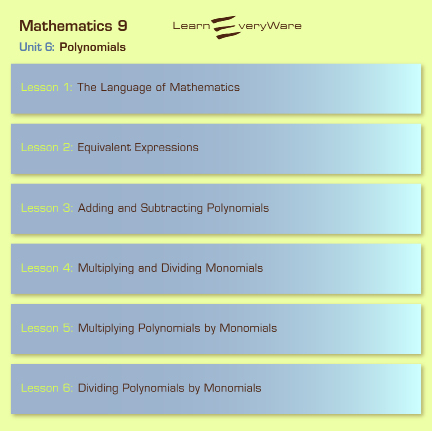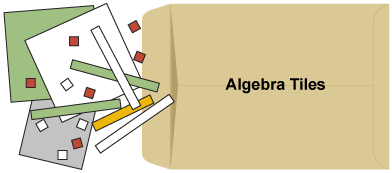Unit 6
Unit 6
Unit 6 Introduction
variable: a symbol (usually a letter) in mathematical expressions and equations
Many different types of situations can be represented by expressions that contain variables. Expressions that contain variables are called algebraic expressions. Algebraic expressions are particularly helpful when you are trying to identify an unknown number or quantity. For instance, you have used many different equations and expressions that contain variables to solve for the area, volume, length, and width of shapes and objects. The Pythagorean relationship, as shown in the photo, is an example of an algebraic equation.

Hemera Technologies/AbleStock/Thinkstock
If you are interested in learning more about variables, go to Variable at the Mathematics Glossary website.
There are many different situations where variables are used to represent unknown quantities. For example, variables may be used to help solve a number trick. Algebraic expressions can also be used to represent the area of features such as ponds, pools, and pathways in landscape design. Solving algebraic equations can be used to identify any missing dimensions of the features.
In this unit you will investigate the following critical question:
-
How can algebraic expressions be used to model various situations?
The concepts and skills associated with algebraic expressions will be presented in six lessons. The first three lessons will look at how algebraic expressions can be used to describe various illusions and number tricks. The final three lessons will look at the role of algebraic expressions in zoning and landscape construction.

Keep up to your assignments as you go through this unit. Keep your work organized, either electronically or in a paper version. This will help you to review and reference the lessons you have learned. Reviewing may help you on tests or while you are working on the unit project. Be sure to talk to your teacher about when and how to submit your assignments.
In this unit there are a variety of assignments you will be asked to complete. Some of these include
-
posting to the discussion board
-
adding samples of your work to your Math 9 course folder
-
developing a formula sheet
-
completing sets of questions for each lesson
-
completing a unit project
-
completing evaluation pieces assigned by your teacher
Throughout this unit you will be using algebra tiles. If you do not have access to a set of algebra tiles, there are a few options available to you.
-
You can print a set of algebra tiles. Cut out the algebra tiles, and store them in an envelope or plastic bag. It is important that you have access to your algebra tiles throughout this unit, so keep them in a safe place.

- You can use the Interactive Algebra Tiles applet. This applet will open up in a new window and allow you to manipulate and arrange algebra tiles as needed.
Strategies for Success
In order to support your success in this unit, follow these strategies.
Strategy 1

Throughout this course you will be building a formula sheet in a spreadsheet program. The purpose of this project is to produce a formula sheet that you can use to quickly identify specific formulas and their uses. It will also provide a way for discussion, analysis, and review of these formulas with your peers.
-
The specific instructions and requirements for the formula sheet are provided to you in the Course Introduction.
-
Keep a look out for the formula sheet icon in the left-hand margin of the lesson you are working on. This is an indication that you can add that formula to your spreadsheet.
Strategy 2
In this unit you will be working with two different chapters in the MathLinks 9 textbook: Chapter 5 and Chapter 7. As such, you may want to make two separate foldables, one for Chapter 5 and one for Chapter 7. Refer to page 172 in the textbook for detailed instructions on creating your foldable for Chapter 5. The instructions for the foldable for Chapter 7 can be found on page 252 of your textbook.
Although this activity may not be graded for marks, you will benefit from this tool. Keep these points in mind as you develop and use this study tool.
- As you are working through the lessons, add formulas, diagrams, examples, key ideas, and glossary words.
- The foldable can serve as a quick reference guide and will help you save time when you are ready to study for your unit test.
Strategy 3
In this unit you will be referring to Chapter 5 and Chapter 7 of your textbook. The pages you will be looking at for Chapter 5 are pages 170 to 205. Chapter 7 is on pages 250 to 283.
- Take time to flip through these textbook pages.
- Look at illustrations, margin features, and main titles to get a sense of where you will be going.
Strategy 4
Read your lessons and textbook materials carefully.
- Pay special attention to tables and diagrams. They have information that will help you understand what you are reading.
- Read and reread material. Take time to ensure you understand it.
- Ask yourself: What is new material to me? What do I already know?
- Move ahead with confidence.

Comstock/Thinkstock
Unit 6 Project
You have the choice of completing one of two projects for Unit 6. Option A is based on the content you will learn in Lesson 1 through Lesson 3. Option B coincides with Lessons 4 to 6.
Option A Project
The Option A Project is part of Lessons 1, 2, and 3. This project is based on the “Math Link” activities on pages 182, 189, 199, and 203 in Chapter 5. As you work through each lesson, you will use variables and algebraic expressions to help correctly solve game show questions and number tricks. You will then use what you have learned about algebraic expressions to develop your own number trick.
Option B Project

iStockphoto/Thinkstock
The Option B Project is part of Lessons 4 through 6. If you choose to complete Option B, you will be designing a landscape plan for a park based on the “Math Link” activities on pages 263, 271, 277, and 281 in Chapter 7. Each of the “Math Link” activities are designed to help you develop the skills you will need to complete your own park design.

Whether you choose to complete Option A or Option B, it is important that you keep your work organized in your portfolio as you progress through each lesson. Be sure to inform your teacher of which project you have chosen to do once you make your decision. You do not need to make a decision right now. In fact, you may want to wait until you have worked through a lesson or two before deciding.
The Unit 6 Project Self-Assessment Rubric can be used to help you assess your work on either the Option A Project or the Option B Project.
You can use this rubric to help you understand how either of the projects will be assessed. The better you understand what the characteristics of quality work are for each project, the easier it will be for you to create high-quality work. Remember, you can always discuss your project with your teacher if you have questions or are unclear about a requirement of any of the project components.
Before you start designing your own landscapes or amazing your friends and family with number tricks, you need to first learn all about algebraic expressions. Your learning starts in Lesson 1 with a look at the role of variables in football and illusions.